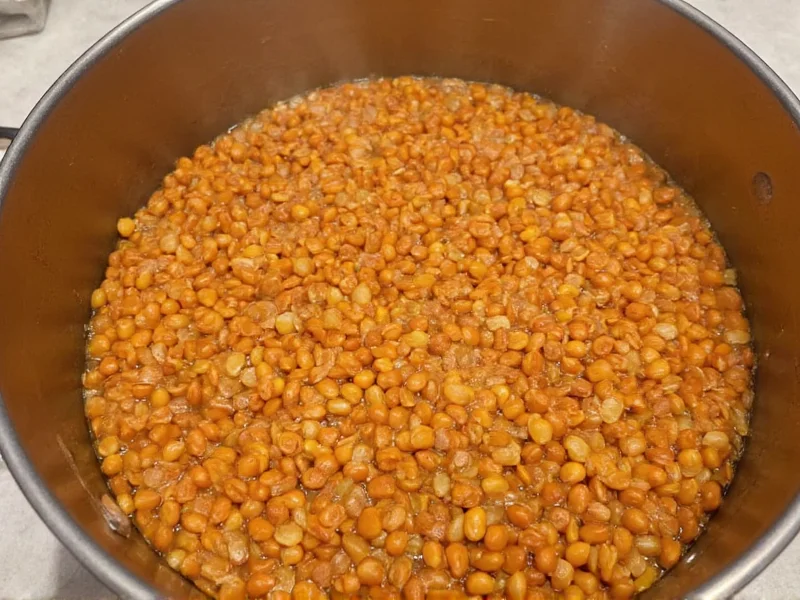Using a rice cooker for lentils transforms this humble legume into a perfectly cooked staple with minimal effort. This method eliminates the guesswork of stovetop cooking while delivering consistent results every time. Whether you're preparing a quick weeknight side or building a protein-packed main course, your rice cooker becomes an unexpected kitchen hero.
Why Cook Lentils in a Rice Cooker?
Rice cookers provide precise temperature control that prevents lentils from boiling over or sticking to the pot. The automatic shut-off feature means you can't accidentally overcook your lentils while attending to other tasks. This hands-off approach yields evenly cooked lentils with ideal texture—tender but not mushy.
Lentil Types and Cooking Requirements
Different lentil varieties require slightly different water ratios and cooking times. Understanding these variations ensures perfect results regardless of which type you choose.
| Lentil Type | Water Ratio | Cooking Time | Best For |
|---|---|---|---|
| Brown/Green | 1:2 | 30-35 minutes | Soups, stews, salads |
| Red/Yellow | 1:1.5 | 20-25 minutes | Dals, curries, purees |
| Black (Beluga) | 1:2.25 | 35-40 minutes | Cold salads, pilafs |
| Puy | 1:2 | 30 minutes | Warm salads, side dishes |
Step-by-Step Cooking Instructions
Follow these simple steps for foolproof lentils every time:
- Rinse thoroughly - Place lentils in a fine-mesh strainer and rinse under cold water until the water runs clear. This removes debris and reduces gas-causing compounds.
- Sort carefully - Check for small stones or discolored lentils and remove them.
- Add ingredients - Combine rinsed lentils, water or broth, and optional aromatics (1 bay leaf, 1 garlic clove, 1 tsp cumin) in the rice cooker pot.
- Select setting - Choose the regular 'white rice' setting for most lentil types. Avoid quick-cook settings which may result in uneven cooking.
- Cook undisturbed - Let the rice cooker complete its cycle without opening the lid. Modern rice cookers automatically switch to 'keep warm' when done.
- Rest and fluff - Allow lentils to rest for 10 minutes after cooking, then fluff with a fork before serving.
Troubleshooting Common Issues
Even with a rice cooker, you might encounter these common problems:
Lentils Too Hard
If your lentils remain firm after the cycle completes, add ¼ cup of hot water and restart the cooking cycle for 5-10 minutes. Older lentils often require slightly more water and time.
Lentils Too Mushy
Overly soft lentils typically result from using too much water or selecting the wrong setting. For firmer lentils next time, reduce water by ¼ cup or choose the 'brown rice' setting which uses lower heat.
Water Boiling Over
If your rice cooker overflows during cooking, you've likely added too many aromatics with high water content (like tomatoes or onions). Stick to dry spices during the cooking phase and add fresh ingredients afterward.
Flavor Variations and Serving Suggestions
Elevate your basic cooked lentils with these simple additions:
- Mediterranean style: Toss cooked lentils with lemon juice, olive oil, chopped parsley, and crumbled feta
- Curry lentils: Stir in coconut milk, curry powder, and diced sweet potato during the last 10 minutes of cooking
- Hearty bowl: Serve over cooked quinoa with roasted vegetables and a tahini dressing
- French lentil salad: Mix Puy lentils with Dijon vinaigrette, diced celery, and hard-boiled eggs
Storage and Reheating Tips
Properly stored, cooked lentils maintain quality for meal prep:
- Cool completely before storing in airtight containers
- Refrigerate for up to 5 days or freeze for 3 months
- Reheat gently with a splash of water to restore moisture
- Add acidic ingredients (lemon, vinegar) after reheating to preserve texture
Maximizing Your Rice Cooker's Potential
Your rice cooker can handle more than just lentils and rice. This versatile appliance excels at cooking other legumes and grains with minimal supervision. For best results with different ingredients, adjust water ratios according to each item's specific requirements. The consistent, gentle heat prevents scorching while ensuring thorough cooking—particularly valuable for busy households seeking reliable meal preparation methods.
Can I cook lentils and rice together in a rice cooker?
Yes, you can cook lentils and rice together using a 1:1.5 ratio of rice to lentils with 3 cups of liquid. Add the rice first, then the lentils on top to ensure even cooking. This creates a complete protein meal with minimal cleanup.
Do I need to soak lentils before cooking in a rice cooker?
No soaking required for most lentil types when using a rice cooker. The extended cooking time at controlled temperature properly hydrates the lentils. Only whole black lentils might benefit from a 2-hour soak for more uniform texture.
How much water do I use for 2 cups of lentils in a rice cooker?
For 2 cups of lentils, use 4 cups of water or broth for brown or green lentils. Red lentils require 3 cups of liquid for the same amount. Always measure both ingredients with the same cup for accuracy.
Can I add salt while cooking lentils in a rice cooker?
Yes, unlike stovetop cooking, you can add salt at the beginning when using a rice cooker. The controlled temperature prevents the salt from interfering with the cooking process. Add ½ teaspoon of salt per cup of dry lentils for best flavor development.
Why do my lentils keep burning in the rice cooker?
Burning typically occurs when using too little liquid or selecting the wrong setting. Ensure you're using the correct water ratio for your lentil type and choose the standard 'white rice' setting. Avoid non-stick spray which can degrade at high temperatures and cause sticking.











 浙公网安备
33010002000092号
浙公网安备
33010002000092号 浙B2-20120091-4
浙B2-20120091-4